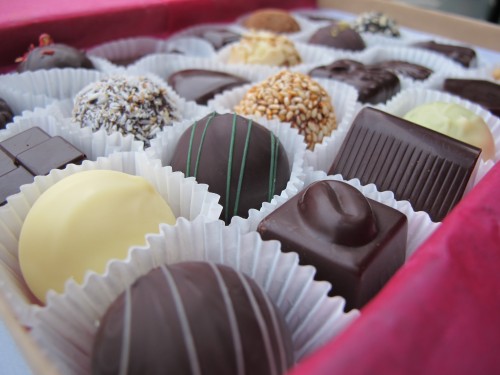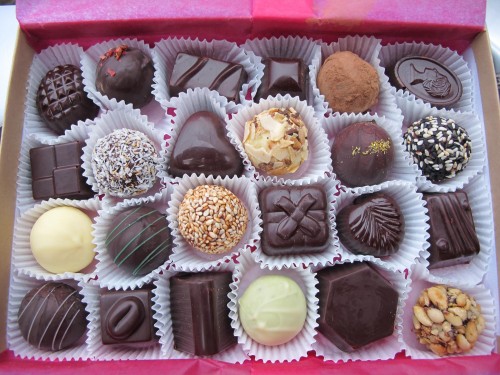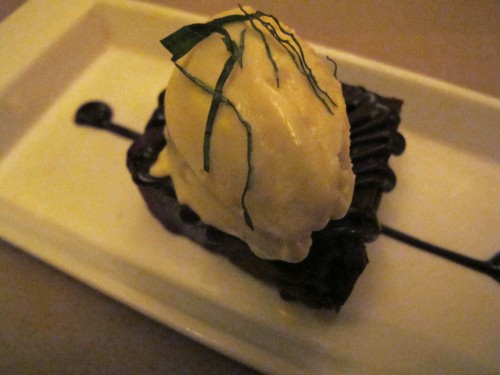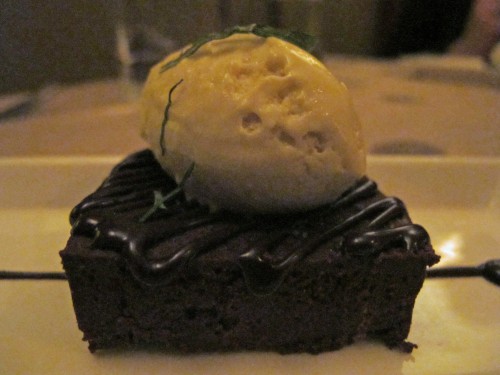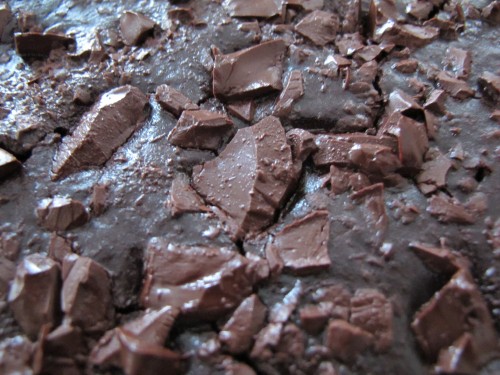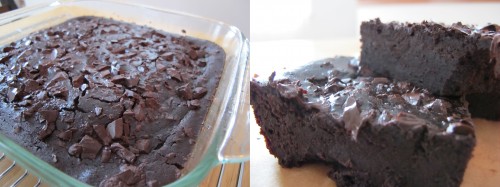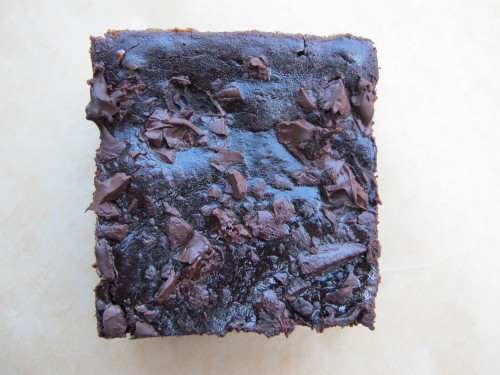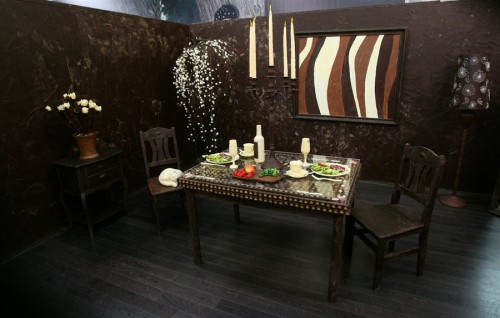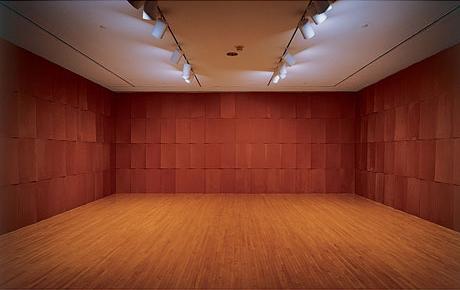Chocolate Travel: Kee’s Chocolates in NYC
The Boy and I took a trip to New York City recently so that we could visit with good friends and experience their magical Manhattan lifestyles. (I also went to a totally fabulous and low-key bachelorette party for one of my beloved college roomies, which left me brimming over with both early-twenties nostalgia and a dreamy optimism for early-thirties futures.) As with so many of our trips out-of-town, we planned our food first and everything else second.
I consider it an obligation to visit Kee’s Chocolates when I’m in New York. The truffles and bonbons are among my favorites in the US. Kee Ling Tong, the chocolatier, specializes in using fresh ingredients in her chocolates. When a chocolate’s description says “fennel,” for example, you can expect to taste and feel the texture of real minced fennel. The Kee’s website explains “The available flavors change with availability of ingredients, and certain flavors remain seasonal.”
Kee’s is a fascinating study in what can be done in a big city full of cash-hearty food lovers that cannot necessarily be done elsewhere. The chocolates are not cheap but, given their quality and the cost of ingredients, they should not be. Most often, Kee makes the chocolates fresh throughout the day in the kitchen next door to her SoHo shopfront, and the shop closes down as soon as the stock is sold out. There is no mail order business – the company will not compromise on freshness of the chocolates – and customers are told that chocolates should be eaten within a few days of purchasing and refrigerated for safe-keeping. Everything else is simple. The chocolate is packaged in plain, crisp cardboard, the shop is sparse and clean. The chocolates speak for themselves. This is all done to great success. Not long ago, Zagat.com readers voted Kee’s the best place to get chocolate in NYC.
Some of my menu favorites? The Balsamic (dark chocolate ganache with balsamic vinegar and pecans), the Black Rose (dark chocolate truffle with black tea infused with rose petals), the Coconut (dark chocolate truffle coated with shredded toasted coconut), and the Lemongrass Mint (a layer of dark chocolate lemongrass ganache with a touch of mint). For a really wild flavor experience, the Passion Fruit (bonbon chocolate filled with dark chocolate ganache) can’t be beat. It makes my taste buds go “Woaaaaaah!”
The Boy is known for buying ALL of the Crème brûlée (dark chocolate bonbon filled with crème brûlée) available in one visit, then carefully spreading out consumption over the next twenty-four hours. A quick perusal of online reviews suggests that he may not be the only chocolate lover with this habit. Neither of us would turn down any Kee’s chocolate, however. On this visit we bought one of each, which worked out perfectly for a box of twenty-four delicious treats. YUM!
Kee’s has two locations:
-
Kee’s Chocolates SoHo
80 Thompson Street
New York, NY 10012
Monday through Friday, 9am to 7pm
Saturday and Sunday, 11am to 7pm
212 334-3284 -
Kee’s Chocolates Midtown
452 Fifth Avenue (inside HSBC)
New York, NY 10018
Tuesday through Friday, 11:00am to 5:30pm
212 525-6099
Chocolate pairing: Chocolate and Basil
Last week, The Boy and I had dinner at Ten Tables Cambridge, a neighborhood restaurant and bar that specializes in seasonal, local foods in an elegant but unpretentious setting.
The occasion was special for a few reasons – we were treated to the dinner thanks to a gift certificate from a friend, we were celebrating milestones in our work lives, and, just that afternoon, we had seen the first crocus and daffodil buds beginning to sprout. It has been a long, cold winter here in New England and even though I know that, come summertime, I will feel nostalgia for the reflective peace of quiet evenings when snow floats down by moonlight, our friendly neighborhood iceberg/enduring snow bank has really started to bring our spirits down. It’s gone from pretty to ugly and now spends its days shvitzing dirty puddle water onto our feet. Those plucky baby flowers poking out of the cold earth are so very welcome. (I still squeal “Ooooh!” every time I catch sight of a patch while walking around the city.)
The food at Ten Tables was lovely (a 4-course vegetarian tasting menu for $30/person) and the service was absolutely excellent. I was most excited to try the dessert, of course, something that I have had my eye on for some time now:
The dessert was a study in flavor contrasts and complements. The chocolate was dark, heavy, and rich. The Thai basil ice cream was sweet, fresh, and peppy; the basil’s flavor hints of anise and mint just peeked through. I also noted the occasional crunch and flavor of the sea salt, a nice contrast to the sweetness of the dish. Many thanks go to Alison Hearn, Ten Tables’ Dining Room and Pastry Chef, for this fabulous dessert, which delighted our palettes and inspired this post!
It was the dessert’s somewhat unusual flavor pairing that got me thinking about the combination of chocolate and basil more generally. The two flavors really work well together, much like chocolate and mint seem to do so naturally. And the flavor possibilities are almost endless, with so many varieties of chocolate and basil to choose from. For example, what might the chocolate terrine have tasted like with a darker, earthier chocolate flavor? Or a brighter, fruitier one? What might an Italian sweet basil in the ice cream have done for the flavor of the dish?
I’ve been plotting a first attempt at urban container gardening for a while now and, with spring and summer just around the corner, the notion of having fresh grown basil to experiment with is almost irresistible. Naturally, I turned to the interwebs to see where other folks’ imaginations have led them in the kitchen.
What did I find? 16 mouthwatering recipes that feature chocolate and basil. (To be clear: none of these are my creations, I have simply linked to them here.)
Thinking back, I remember that I once sampled another approach to the chocolate and basil combination at Kee’s Chocolates in Manhattan. Kee’s Lemon Basil bonbon (photo here) features dark and white chocolate combined with fresh lemon and basil.
No doubt there are many other options out there. (For example, it looks like Theo Chocolate did a seasonal basil bonbon in the past.) I would love to hear about more treats like these, so please do send any recommendations on over.
An urban myth suggests that there exists a type of basil that smells like chocolate (not true, though that’d be very cool), and dozens of gardener’s forum posts are devoted to the impossible-to-find herb. These two fabulous flavors have even found musical expression in French punk rock/indie band The CHOCOLATE’s song “Basil” (ha!).
As a side note, I should point out that almost none of the recipes listed above turned up when I searched using Google’s new Recipe View, which has been in the news quite a bit lately, and which many are, understandably, excited about. The search function has great potential to help in weeding through dense web results. Unfortunately, a search on Recipe View brings up a limited number of recipes that are not nearly as inventive as those I found through a standard Google search. The problem: for now, at least, Google’s Recipe View algorithm searches mostly big name recipe sites, neglecting the many high-quality food blogs out there. Techies and food bloggers can learn more about the plusses and pitfalls of Google Recipe view via two incredibly helpful posts from Food Blog Alliance and foodblogforum. This is definitely something to keep in mind when recipe searching online – chocoholics shall not be limited by search engine snafus!
Looks like I’m in for a busy summer of pairing basil with chocolate. YUM!
Chocolate Recipe: Black Bean Brownies
Well before starting this blog, when it was still just an unrealized idea, I debated long and hard about whether I would include recipes and/or chocolate cooking tips. I am not by any stretch of the imagination a kitchen professional or a nutritionist (an extra big HA! to the latter). My formal training is limited to a series of baking classes taken at the Cambridge School of Culinary Arts and an introductory chocolatier class taken at the online institution Ecole Chocolat. My informal training, however, has been rich and full of fun.
I fell in love with cooking thanks to my grandmother, an exceptional former professional baker, who very early in my life taught me to use her flour sifter when we put together pancake or cookie batter. I can remember watching the flour float down into the bowl (and probably all over the counter, come to think of it…) with wonder, holding onto a wooden spoon and mixing with all my might, then watching excitedly as heat turned the batter into something else altogether, something magical.
The magic of baking continues to amaze me. Today, many of my favorite activities involve sharing food with friends and family. I am thrilled, for example, when someone invites me to an event and, remembering my love of sweets, charges me with bringing the dessert (I always bring dessert!). I spend days in advance reading through cookbooks, watching TV programs, internet surfing, and hands-on experimenting for inspiration and practice.
I’m actually a bit of a baking snob now, and I regularly do things like weigh my ingredients for accuracy and alter recipes when I think the suggested techniques are inadequate. I mean, if you’re going to do it, why not do it right and make the most fabulous and sweet treat that you can? Of course, this only goes so far. The girl might vociferously critique mass corporate baking, but if you offer her a Twinkie, she’s not about to turn it down.
So here we go, for better or worse, with a first recipe post. I can’t promise not to give bad instructions or provide incorrect information from time to time. Nor can I guarantee that my opinions on food politics and ethics are set in stone. They’re quite the opposite, in fact, and I expect that they will morph along with this blog as I learn and write more.
I can promise, however, to do my darnedest to find a special recipe each time and to write it up carefully and thoughtfully. The recipes that I choose will be either stellar examples of classic chocolate dishes or recipes that feature unique ingredients or techniques. I hope that they will prove of interest to you fellow chocolate lovers and contribute to our discussions here. Enjoy!
Black Bean Brownies
I happened upon this recipe completely by accident, while searching through a series of articles about chocolate. The recipe was printed in an article in the Columbia Daily Tribune, entitled “Black beans abound in these high-fiber, low-fat brownies.” I was drawn to these brownies because of the originality of one of the main ingredients – black beans. The use of black beans instead of flour seemed to promise a moist heaviness, something I typically feel is essential to a successful brownie. The result is really wonderful – the brownies are moist and not too sweet, with a light fudge-yness to them (to get heavy fudge-yness, I think one would simply have to add more fat). I used dark chocolate and it shined through. There was a slight flavor of black bean hiding in the background, but neither I nor my two helpful taste testers deemed it to be in any way a problem. These brownies are an interesting alternative, especially for folks looking for something without processed flour or with somewhat less fat and sugar and somewhat more fiber and protein than the average brownie.
The recipe’s authors are celebrity chef Amanda Freitag (known to many for her work as a judge on the Food Network’s Chopped) and dietitian (and fellow Massachusetts local) Julie Barto, MS, and it was designed for the Multiple Sclerosis Active Wellness Program.
The ingredients list below comes directly from Freitag and Barto’s recipe – I’ve only tweaked the chocolate quantity. I have also rewritten the instructions to clarify techniques and added some of my own suggestions about how to customize the chocolate content to your own tastes.
Ingredients
- 1 15 oz can black beans
- 1/4 C water
- 3 whole eggs
- 3 T canola oil
- 1 t vanilla extract
- 1/2 C unsweetened 100% cocoa powder*
- 2/3 C packed brown sugar or 3/4 C white granulated sugar
- 1/2 t baking powder
- 1 pinch salt
- 1 C semi sweet chocolate chips (or chopped dark chocolate, percentage of your choosing)*
- cooking spray (to coat baking dish)
Instructions
- Preheat oven to 350 degrees.
- Spray an 8”x8” baking dish with cooking spray and set aside. (Alternatively, you could fully line the baking dish with parchment paper, both bottom and sides.)
- Rinse and drain black beans well.
- If using dark chocolate in place of chocolate chips, chop into small ¼”-½” chunks and set aside.
- Place black beans and water in a food processor or blender and process until smooth.
- Add eggs, oil, vanilla extract, cocoa powder, salt, baking powder, and sugar to the food processor or blender, and again process until smooth, making sure that batter is mixed thoroughly.
- Next, add approximately ½ of the chocolate and pulse quickly to mix into the batter.
- Pour the batter and spread evenly into the prepared baking dish. Sprinkle the remaining chocolate over the top.
- Bake for 30-35 minutes. Indicators of doneness: A toothpick inserted at the center of the baking dish will come out clean. The top of the brownies will appear somewhat dry and the edges will start to pull away from sides of the baking dish.
- Let brownies cool thoroughly, preferably by placing the pan on a cooling rack.
- Once brownies are thoroughly cooled, cut and carefully remove from pan. Depending on how you cut these, you can end up with anywhere from 9 large-ish brownies to 16-18 small-ish ones.
- Serve and enjoy!
- Storage: I tend toward caution when eggs are involved, so I recommend storing these brownies in an airtight container in the fridge. Before eating refrigerated brownies, just let them sit out until they return to room temperature.
* Chocolate content suggestions:
If you prefer a more toned down chocolate flavor (more for milk chocolate lovers, or folks who dislike the bitterness of dark chocolate), I recommend using a high quality Dutch-processed/alkalized unsweetened cocoa powder. Semi sweet chocolate chips will also keep the intensity of the chocolate flavor in check.
If you are a hardcore chocoholic (e.g. the type to scoff at chocolate with measly percentage numbers), then I recommend substituting a dark chocolate with a percentage of your choosing for the semi sweet chocolate chips. A high quality Dutch-processed/alkalized unsweetened cocoa powder will nicely complement the dark chocolate. Or, if you prefer the bitter notes of dark chocolate, using a high quality natural unsweetened cocoa powder could help to ensure a deep chocolate flavor.
Note: For an interesting comparison of Dutch-processed and natural cocoa powder, see this article from Cook’s Illustrated.
Like these brownies? There are more Black Bean Brownie recipes to be tried!
While searching for more instances of black bean use in brownie recipes, I came across this lovely recipe by Ania Catalano, from her book Baking with Agave Nectar. Blogger and author Heidi Swanson posted the recipe on her site 101cookbooks. The recipe has some interesting ingredient differences (butter, agave nectar, coffee) from the one that I tested for this post – I can’t wait to try it.
Those looking for a vegan black bean brownie recipe can find one already out there in the blogosphere. Happy Herbivore has a recipe described as “dense, fudge-y, and ultra-healthy” that incorporates agave nectar, rolled oats, and cinnamon (a nice spice twist, for sure). It looks fantastic.
Recent Stories in Chocolate News
Chocolate is often in the news, offering more evidence that it has captured our society’s interest and imagination. Over the past several weeks, a few stories have stood out and have the potential to significantly impact the chocolate world. Below, I’ve compiled links to some of the big headlines, along with my own commentary.
Increases in cocoa prices
In mid-February, cocoa prices reached a 32 year high, prompting a flurry of news articles, hedge fund activity, and speculation about what this might mean for the chocolate industry and consumers. The price fluctuation has been caused by a number of factors, especially serious political unrest in Ivory Coast, where 60% of the world’s cacao cultivation takes place. Sugar prices have also fluctuated toward higher prices as of late, although most recently they have dropped slightly.
- NPR’s coverage of changes in cocoa prices provides basic sociohistorical context. You can listen and read here: Rising Cocoa Prices May Leave Chocolate Fans Bitter.
- This article, from Inside Futures, summarizes various bullish and bearish factors (phew! how animalistic!) in the price changes of these commodities. It includes charts that illustrate price fluctuations. Foods and Softs Outlook – February 18, 2011.
Political Upheaval in the Ivory Coast
In the fall of 2010, the Ivory Coast held a presidential election, the results of which are still in dispute. Laurent Gbagbo held the office of President until the election, when he likely was defeated by opponent Alassare Ouattara. Gbagbo steadfastly refuses to leave office, however, and has gone so far as to unleash violent, often ethnically and religiously based attacks on protesters and to order UN peacekeepers to leave the country (they have refused). Other countries have imposed increasingly severe sanctions on Ivory Coast, and the sale and export of cocoa is in jeopardy.
This article, and the following video from Voice of America, offer more information, especially in relation to cocoa: Ivory Coast Economy Drops Amid Political Impasse.
BAMCO switches to Fair Trade chocolate
On February 7, 2011, Bon Appétit Management Co., a large food provider for colleges, corporations, and special events, announced that it would begin using Fair Trade chocolate in all of its 400 plus kitchens. The baking chocolate will be sourced from Cordillera Chocolate, a Fair Trade Certified company.
Numerous articles about this decision are available on the web. I recommend the following:
- Bon Appétit Management Co.’s Press Release, with details on the decision and Cordillera Chocolate: For Immediate Release.
- A thoughtful article about chocolate, taste, and trade policy, written by Helene York, director of strategic initiatives for BAMCO, via The Atlantic online: Chocolate Is Sweet, But Chocolate Policy Would Be Sweeter.
- An article from Change.org, which celebrates BAMCO’s decision and questions why other companies have yet to do the same: Bon Appétit: Enjoy Fair Trade Chocolate!
Blommer Chocolate Co.’s Huge Cocoa Shipment
North America-based Blommer Chocolate Co. recently received the largest cacao bean shipment ever after purchasing 18,400 metric tons of the stuff. Blommer is no stranger to large quantities – the company’s website states: “Blommer Chocolate is the largest cocoa bean processor in North America (145,000 Metric Tons); 5% of World Cocoa Crop.” Perhaps even more remarkable than the size of the shipment is the fact that this cocoa was Rainforest Alliance certified and purchased in accordance with Blommer Chocolate Co.’s commitment to sustainability. Read more here: Blommer Gets Major Cocoa Shipment.
Chocolate melts, whether we want it to or not
Chocolate manufacturers have, for many years, tried to produce chocolate that does not so easily melt when exposed to heat. Just imagine the possibilities! A number of ingredient additions can help to prevent melting – sugar, oat flour, gelatin, or cornstarch, for example – though these things can significantly affect taste. This article gives a brief summary of some of the results from research and suggests that manufacturers still have a ways to go before they are able to produce a magical non-melting chocolate: Hot Chocolate: No Heat Resistant Solution Says Review.
Just for fun: Chocolate Chemistry
2011 has been named the International Year of Chemistry (IYC2011) by the International Union of Pure and Applied Chemistry (IUPAC) and the United Nations Educational, Cultural, and Scientific Organization (UNESCO). In honor of IYC2011, Scientific American has partnered with NBC Learn’s ChemistryNOW (which arose out of a partnership with the National Science Foundation). All of this is to say that these formal proclamations and initiatives around chemistry have led, in part, to this article and the following short video about the chemistry of chocolate. The video shows that science is part of why chocolate tastes so darn good. Enjoy!
Chocolate Rooms: “Eatable” Art
One of the most widely reported stories in chocolate news last week had to do with a room made entirely from chocolate, now on exhibit in a supermarket in Vilnius, the capital city of Lithuania. Modeled to look like a typical Lithuanian sitting room, the exhibit is 17 square meters in size (approximately 183 square feet), and features walls, furniture, flowers, candles, dishes, and even food, all made out of chocolate. Artist Mindaugas Tendziagolskis, working with a team of chocolate crafters, used approximately 300 kilograms (approximately 661 pounds) of chocolate in the construction of the room. This was all done just in time for Valentine’s Day.
Several more photos of the room are available, as well as a video with brief artist and audience interviews.
The room will remain on display in Vilnius until March 8, 2011, when it will be disassembled… and CONSUMED!
Reading about this room got me thinking about the importance of understanding chocolate as art. This type of chocolate architecture, or large scale chocolate sculpture, is increasingly common. Chocolate rooms, in particular, have been imagined for at least several decades and often symbolize lavish extravagance or ridiculous whimsy. On a smaller scale, one can often find chocolate sculptures in shops or restaurants or observe nerve-wracking chocolate sculpting competitions on the Food Network. Chocolate is a fascinating, formidable medium for artistic creation, and one that affects multiple senses of its audience – sight, smell, touch, and taste. (Well, maybe hearing, too, if the pieces come crashing and crumbling down… oh, the heartbreak!)
Charlie and the Chocolate Factory: The Chocolate Room
Charlie and the Chocolate Factory, the classic children’s book by Roald Dahl (1964), features “The Chocolate Room,” the very first room that a group of lucky golden ticket winners and their parents tour along with Willy Wonka, the eccentric proprietor of the Wonka Chocolate Factory. Opening the door to the room reveals a veritable wonderland – a valley with green meadows, lush trees, bushes, and flowers, and a great river flowing with melted chocolate.
Mr. Wonka then explains the room’s purpose:
“There!” cried Mr. Wonka, dancing up and down and pointing his gold-topped cane at the great brown river. “It’s all chocolate! Every drop of that river is hot melted chocolate of the finest quality. The very finest quality. There’s enough chocolate in there to fill every bathtub in the entire country! And all the swimming pools as well! Isn’t it terrific? And just look at my pipes! They suck up the chocolate and carry it away to all the other rooms in the factory where it is needed! Thousands of gallons an hour, my dear children! Thousands and thousands of gallons!”
The children and their parents were too flabbergasted to speak. They were staggered. They were dumbfounded. They were bewildered and dazzled. They were completely bowled over by the hugeness of the whole thing. They simply stood and stared.
“The waterfall is most important!” Mr. Wonka went on. “It mixes the chocolate! It churns it up! It pounds it and beats it! It makes it light and frothy! No other factory in the world mixes its chocolate by waterfall! But it’s the only way to do it properly! The only way! And do you like my trees?” he cried, pointing with his stick. “And my lovely bushes? Don’t you think they look pretty? I told you I hated ugliness! And of course they are all eatable! All made of something different and delicious! And do you like my meadows? Do you like my grass and my buttercups? The grass you are standing on, my dear little ones, is made of a new kind of soft, minty sugar that I’ve just invented! I call it swudge! Try a blade! Please do! It’s delectable!”
This scene was dramatized in the classic 1971 film Willy Wonka & the Chocolate Factory, starring Gene Wilder as Wonka, and includes the famous song “Pure Imagination,” which is equal parts eerie and dreamy:
Tim Burton’s take on Charlie & the Chocolate Factory (2005) features Johnny Depp as Wonka, and brings the description of the room’s charming “eatable-ness” into the realm of the rather bizarre.
In the book, Augustus Gloop, of the “enormous stomach,” sneakily samples chocolate from the river and falls in, only to be sucked into a pipe, clogging it up. Willy Wonka sends Augustus’ parents off to retrieve him in another room of the factory with the aid of an Oompa-Loompa, while the rest of the Ooompa-Loompas sing a very unflattering song about Augustus’ size and appetite to the rest of the tour group. (The troubling issue of the cacao bean-obsessed Oompa-Loompa tribe will most certainly be taken up in a subsequent post.)
Edward Ruscha: Chocolate Room
A more abstract approach to using chocolate in the construction of a room comes in the form of Edward Ruscha’s installation Chocolate Room, which debuted in 1970 and was again exhibited at The Los Angeles Museum of Contemporary Art in 2004.
This description, taken from the MOCA website, gives more information:
For its debut at the 35th Venice Biennale in Italy, Chocolate Room originally consisted of 360 shingle-like sheets of paper silk-screened with chocolate and applied to the interior walls of the gallery space. Edward Ruscha was just starting to work with organic materials in his prints, using such unconventional substances as blood, gunpowder, or cherry juice instead of traditional inks. During the summer of 1970, curator Henry Hopkins invited Ruscha and several other artists to make a work for the American Pavilion as part of a survey of American printmaking with an on-site workshop. Many declined the invitation in protest against the Vietnam War; Ruscha intended to do the same, but eventually reconsidered. When Chocolate Room went on view in Venice, protesters etched anti-war slogans into the rich brown surfaces of Chocolate Room, leaving it to stand as a spontaneous anti-war monument, which Ruscha ultimately considered more effective than non-participation in the Biennale. In the summer heat, the heady smell of chocolate was particularly overwhelming and attracted a swarm of Venetian ants, which ate away at the work. MOCA acquired Chocolate Room in 2003 and silk-screens new chocolate panels each time it is installed.
Promotional Decadence: Godiva Suites and Sets
Various other chocolate rooms have popped up from time to time, most often for the sake of novelty and marketing, such as the “Godiva Decadence Suite” in New York’s Bryant Park Hotel in 2008 (and again in 2009). The suite included a chocolate reinterpretation of Gustav Klimt’s “The Kiss,” a Jackson Pollock-inspired piece, and chocolate “Pucci” armchairs. Godiva ran a promotional competition involving the suite, and a winner was awarded a trip to New York City for two to stay in the suite and participate in a variety of chocolate-themed activities. Godiva’s press release explains more, and the room can be seen in detail in this video.
Perhaps the most widely viewed chocolate architecture exhibit, however, was on the February 22, 2010, Oprah Winfrey Show episode “That’s Incredible!,” which reached millions of viewers. For one day, Oprah’s set was made of Godiva chocolate from top to bottom, a feat of chocolate engineering and ingenuity. The set took 800 boxes filled with 52 different kinds of chocolate and 1400 hours of labor to make.
I could describe this more, but it is really so much better to see it: The Making of Godiva’s Chocolate Set (Video)
Detailed photos are also available. I especially love the elaborate crystal chocolate chandelier that took dozens of man-hours to make. The chocolate wine glasses are also to die for – what craftsmanship!
Oprah, who appeared gleeful to be surrounded by such chocolate opulence, remarked on the fantastic smell on set (ooh la la!) and mentioned that the audience would be munching on it at the end of the taping. This, of course, brings up lots of questions about how the chocolate in these chocolate rooms was handled and for how long it was exposed to swarms of visitors. I am crinkling up my nose just thinking about the questionable sanitation. Oh, who am I kidding, I would totally eat that.
For the record, the set was designed by Larry Abel and Raymond McCallister of Larry Abel Designs. They design and plan events, often for fancy pants celebrity shindigs, and have on numerous occasions built events around elaborate chocolate sets. If that’s not inspiration to create your own job for an awesome niche market, then I don’t know what is.
DIY Chocolate Architecture: In Your Living Room
For those bravehearted readers with a hankering to get started on making their own chocolate rooms, celebrity chocolatier Jacques Torres teamed up with the Food Network to offer a “Do It Yourself Chocolate Sculpture” recipe, which takes 5 hours of prep time, has a skill level of “difficult,” and yields one large chocolate sculpture.
Alternatively, the folks at Special K Chocolatey Delight cereal seem to believe that we can just imagine ourselves a room, even a city, of chocolatey delight, as evidenced by this recent commercial:
The attention to detail and care with which chocolate rooms are put together is mind blowing. There’s something almost achingly beautiful about works of art created from fragile, perishable materials like chocolate. These works celebrate the ephemeral sensuality of chocolate, and challenge us to understand them in light of their inevitable demise. For they are, indeed, hopelessly breakable, melt-able, rot-able, and “eatable.”
There is no
Life I know
To compare with
Pure imagination
Living there
You’ll be free
If you truly
Wish to beFrom the song “Pure Imagination,” by Leslie Bricusse and Anthony Newley
